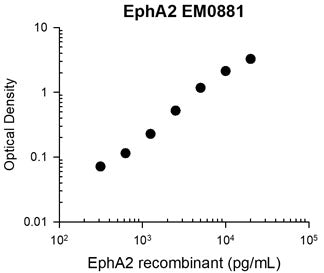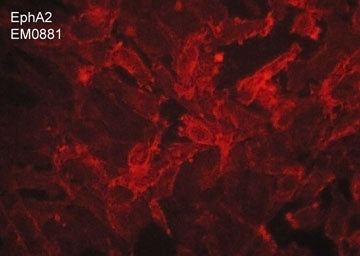Anti-EphA2 (Extracellular region) M088 Antibody
- SPECIFICATION
- CITATIONS
- PROTOCOLS
- BACKGROUND

Application
| WB |
|---|---|
| Primary Accession | P29317 |
| Host | Mouse |
| Clonality | Mouse Monoclonal |
| Isotype | IgG1 |
| Clone Names | M088 |
| Calculated MW | 108266 Da |
| Gene ID | 1969 |
|---|---|
| Other Names | EphA2, P29317, Epithelial cell kinase, Tyrosine-protein kinase receptor ECK, Ephrin type-A receptor 2 |
| Target/Specificity | The Eph family of receptor tyrosine kinases and their Ephrin ligands are important for cell positioning and morphogenesis during development. Eph receptors are classified into 10 EphA and 6 EphB receptors, which preferentially bind to the type A and type B ephrins, respectively. Ephrin type-A receptor 2 (EphA2), also known as epithelial cell kinase (Eck), binds the ephrin A1 (EFNA1) ligand, and has roles in neuronal development and repair, as well as carcinogenesis. EphA2 receptor has an N-terminal ligand-binding domain followed by a cysteine-rich domain with an epidermal growth factor-like motif and two fibronectin type-III repeats in the extracellular region, and a sterile alpha motif (SAM), and a PDZ domain-binding motif in the intracellular region. EphA2 is expressed in many types of cancers, including breast, colon, bladder, gastric, and glioblastoma. In bladder cancers, EphA2 may be activated by progranulin leading to phosphorylation at Ser-897 and bladder tumorigenesis. EphA2 may be an important therapeutic target and biomarker for several types of cancer. |
| Dilution | WB~~1:1000 |
| Storage | Maintain refrigerated at 2-8°C for up to 6 months. For long term storage store at -20°C in small aliquots to prevent freeze-thaw cycles. |
| Precautions | Anti-EphA2 (Extracellular region) M088 Antibody is for research use only and not for use in diagnostic or therapeutic procedures. |
| Shipping | Blue Ice |

Thousands of laboratories across the world have published research that depended on the performance of antibodies from Abcepta to advance their research. Check out links to articles that cite our products in major peer-reviewed journals, organized by research category.
info@abcepta.com, and receive a free "I Love Antibodies" mug.
Provided below are standard protocols that you may find useful for product applications.
Background
The Eph family of receptor tyrosine kinases and their Ephrin ligands are important for cell positioning and morphogenesis during development. Eph receptors are classified into 10 EphA and 6 EphB receptors, which preferentially bind to the type A and type B ephrins, respectively. Ephrin type-A receptor 2 (EphA2), also known as epithelial cell kinase (Eck), binds the ephrin A1 (EFNA1) ligand, and has roles in neuronal development and repair, as well as carcinogenesis. EphA2 receptor has an N-terminal ligand-binding domain followed by a cysteine-rich domain with an epidermal growth factor-like motif and two fibronectin type-III repeats in the extracellular region, and a sterile alpha motif (SAM), and a PDZ domain-binding motif in the intracellular region. EphA2 is expressed in many types of cancers, including breast, colon, bladder, gastric, and glioblastoma. In bladder cancers, EphA2 may be activated by progranulin leading to phosphorylation at Ser-897 and bladder tumorigenesis. EphA2 may be an important therapeutic target and biomarker for several types of cancer.
If you have used an Abcepta product and would like to share how it has performed, please click on the "Submit Review" button and provide the requested information. Our staff will examine and post your review and contact you if needed.
If you have any additional inquiries please email technical services at tech@abcepta.com.













 Foundational characteristics of cancer include proliferation, angiogenesis, migration, evasion of apoptosis, and cellular immortality. Find key markers for these cellular processes and antibodies to detect them.
Foundational characteristics of cancer include proliferation, angiogenesis, migration, evasion of apoptosis, and cellular immortality. Find key markers for these cellular processes and antibodies to detect them. The SUMOplot™ Analysis Program predicts and scores sumoylation sites in your protein. SUMOylation is a post-translational modification involved in various cellular processes, such as nuclear-cytosolic transport, transcriptional regulation, apoptosis, protein stability, response to stress, and progression through the cell cycle.
The SUMOplot™ Analysis Program predicts and scores sumoylation sites in your protein. SUMOylation is a post-translational modification involved in various cellular processes, such as nuclear-cytosolic transport, transcriptional regulation, apoptosis, protein stability, response to stress, and progression through the cell cycle. The Autophagy Receptor Motif Plotter predicts and scores autophagy receptor binding sites in your protein. Identifying proteins connected to this pathway is critical to understanding the role of autophagy in physiological as well as pathological processes such as development, differentiation, neurodegenerative diseases, stress, infection, and cancer.
The Autophagy Receptor Motif Plotter predicts and scores autophagy receptor binding sites in your protein. Identifying proteins connected to this pathway is critical to understanding the role of autophagy in physiological as well as pathological processes such as development, differentiation, neurodegenerative diseases, stress, infection, and cancer.



